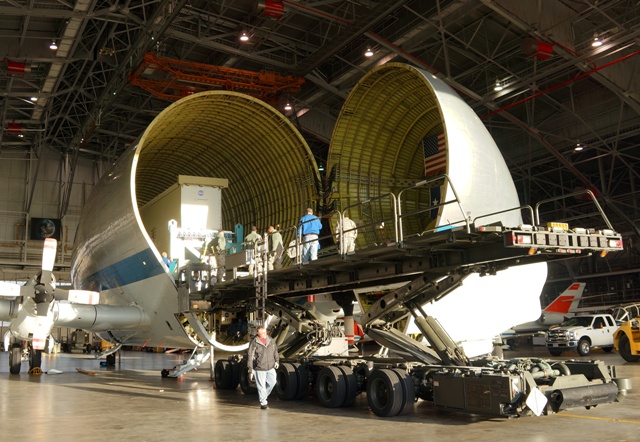 Air Force personnel from nearby Joint Base Langley-Eustis unloaded the composite test article.Image Credit: NASA/Kathy Barnstorff
Air Force personnel from nearby Joint Base Langley-Eustis unloaded the composite test article.Image Credit: NASA/Kathy Barnstorff
NASA’s Super Guppy plane has hauled a huge composite fuselage cross-section from Long Beach, California to the Langley Research Center in Virginia for testing. This plane resembles a giant fish and is based at the Houston facility of NASA's Johnson Space Center.
The composite fuselage is a multi-bay box which weighs 4,536kg and has a width of 9.14m. It is part of the central hybrid wing body of an innovative airplane design. The researchers at Virginia will be testing this structure by bending, pressurising and finally breaking it. The Pultruded Rod Stitched Efficient Unitized Structure (PRSEUS) concept is a stitched composite structure which makes use of a damage-tolerant and low-weight concept.
Boeing Research & Technology in California had built the test article for NASA's Environmentally Responsible Aviation (ERA) project, which is part of NASA's Aeronautics Research Mission Directorate. The test article that was assembled in Long Beach would be the largest structure that has been tested at NASA Langley's Combined Loads Test System (COLTS) facility until now.
We chose to use the Super Guppy because it could easily accommodate the large structure, which is representative of a cross-section of a 75-percent scale futuristic hybrid wing body aircraft fuselage.
Dawn Jegley, lead NASA engineer on the PRSEUS project.
The Super Guppy is designed to carry a payload of over 23,587kg or 26t. It is 33.8m long, with a height of 7.6m and a width of 7.6m. A hinged nose is a unique feature of the plane, which allows it to be opened by more than 200°. This allows large cargo pieces to be loaded as well as unloaded from the front portion of the plane.
In 1968, a Guppy airplane had carried a Lunar Landing Training Vehicle to NASA Langley. In 1977, a prototype of a XFV-12A vertical takeoff and landing aircraft was delivered and in 1979 a component for the National Transonic Facility at Langley was delivered.
The Super Guppy cargo carrier was moved to the NASA Langley hangar. Here, the pallet carrying the multi-bay box in the cargo carrier was removed using a Tunner 60K aircraft cargo loader/transporter. This was carried out by a U.S. Air Force crew at the 633rd Logistics Readiness Squadron based at Joint Base Langley-Eustis.
The Tunner 60K aircraft cargo loader/transporter moved the pallet with the test article a distance of about five blocks. Security police from NASA Langley escorted the movement until it reached the COLTS facility.
At this point a crane was used for lifting and transferring the multi-bay box into the COLTS facility. Next year engineers will perform tests involving extreme combined pressure and bending loads to ascertain the strength of the article. They will continue the test until the box fails.
NASA has developed the PRSEUS concept in collaboration with the U.S. Air Force Research Laboratory (AFRL) and The Boeing Company. This concept does not require a size-restricting autoclave as the carbon-epoxy panels are infused with resin and then cured using vacuum pressure. This enables fabrication of the structure in pieces having a larger size.
Super Guppy Delivers Composite Test Structure
"Another advantage to PRSEUS is that stitching the layers together allows aircraft manufacturers to use fewer fasteners – reducing cost, weight and the number of places where cracks can develop," added ERA project manager Fay Collier. The manufacturing process involves stitching of the layers of the structure.
To stiffen the structure, carbon-fiber rods are then inserted. This new fabrication concept could help achieve a 25% reduction in weight when compared to using other aircraft composite applications.
Labs at NASA Langley have tested stitched composite pieces infused with resin that are smaller in size. These pieces have also been used in the main landing gear doors and fairings of the C-17 Globemaster and other such aircraft.
The ERA project aims to achieve simultaneous reduction in emissions, noise levels and fuel consumption in transport planes of the future. The structural test being performed at NASA Langley is one among the eight integrated technology demonstrations on a large-scale that are intended to advance the ERA project.